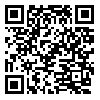BibTeX | RIS | EndNote | Medlars | ProCite | Reference Manager | RefWorks
Send citation to:
URL: http://tumj.tums.ac.ir/article-1-692-en.html
Background: Joint trauma and injury are the most common causes of dynamic instability. Dynamic instability has a great effect on the lumbar spine, due to its three-dimensional motions. The greatest amounts of compression and shearing force are imposed at the points of maximum torque and velocity. The changes in these phase angles upon bearing various loads can cause some pathologic conditions. In this study, we examined the phase angle at maximum torque and velocity in the three planes of movement and then estimated their displacement upon external loads.
Methods: Using the B200 isoinertial dynamometer, 13 subjects were tested in three stages as follows: 1) Familiarization with tests and apparatus. 2) Warm-up and three maximum isometric tests, with a rest interval between each test, in the three axes of lumbar motion including: flexion/extension, rotation to right/left, lateral flexion to the right/left. 3) Five dynamic tests in these three axes of motion without load, with 25% maximum voluntary torque, and with 50% maximum voluntary torque. Special software was used to analyze the raw data and detect the occurrence of maximum torque and velocity in the dynamic range of motion at each of the three axes.
Results: When the load was increased, the maximum dynamic torque in each of the three axes increased (P<0.05). The increase in load shifted the phase angles toward the maximum torque and velocity (P<0.05), with a positive correlation between changes in torque and velocity phase angles (P<0.05).
Conclusions: Rather than being a function of the biomechanical pattern, the changes in maximum torque and velocity of the phase angles following an increase in motion resistance to the outer range of the three axes are actually a control behavior in the motion processing system in dynamic movement.
| Rights and permissions | |
 |
This work is licensed under a Creative Commons Attribution-NonCommercial 4.0 International License. |





